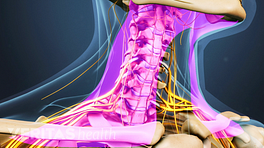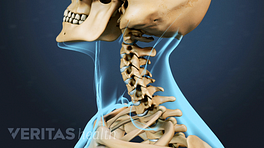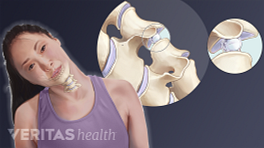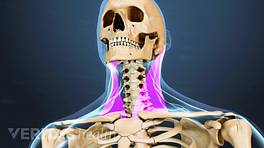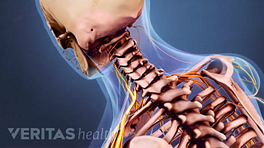Cervical myofascial pain syndrome is a condition in which the layer of connective tissue that surrounds your neck muscles (fascia) becomes tight or damaged. The result is often:
- Tight or achy neck muscles that may limit your range of motion.
- Pain that spreads from your neck to nearby parts of the body, such as the head and shoulders.
- Knots you can feel in your neck and/or upper back, sometimes called trigger points, which hurt when you press them. (There is not a consensus in the medical literature about what a trigger point is and what causes it.)
Cervical myofascial pain syndrom often results in trigger points—knots in the neck and/or upper back, sometimes that cause pain when pressed. Read Trigger Point Exercises for Neck Pain
This condition is often thought to be caused by previous injury, repetitive neck movements, overuse, stress, and/or poor posture. Read on to learn how to treat it.
Self-care tips for treating cervical myofascial pain syndrome
There are several treatments you can do on your own that may reduce your myofascial neck pain:
- Exercise. Perform gentle exercises that stretch and strengthen neck and upper back muscles to help ease tightness, improve posture, and reduce myofascial pain. Aerobic activity, such as biking, swimming, and walking, is also recommended.
- DIY massage. You can find temporary pain relief by giving yourself a trigger point massage. Lie on your back and gently smooth out the tight knots with a foam roller or tennis ball underneath your neck and/or upper back.
- Heat therapy. Applying heat soothes constricted muscles by dilating local blood vessels and increasing blood flow to the painful area. Only use heat therapy (such as an electric heating pad) on your neck for 20 minutes at a time, and always protect your skin with a barrier.
- NSAIDs (non-steroidal anti-inflammatory drugs). Taking over-the-counter medications such as ibuprofen (e.g., Advil, Motrin) and naproxen (e.g., Aleve) may help reduce inflammation and offer enough relief for you to stretch and exercise. Follow the label’s directions carefully before use.
- Relaxation techniques. Deep breathing exercises and meditation can reduce stress and muscle tension in the body.
It is best for self-care to be practiced under the guidance of a health care provider. If any of these tips increase your pain, stop immediately.
How health care providers may treat myofascial pain syndrome
Here are some ways you can expect health care providers to provide you with treatment:
- Myofascial release therapy. A health care provider such as a chiropractor, osteopathic physician, or physical therapist may treat your myofascial pain syndrome using something called myofascial release therapy. This therapy uses gentle direct pressure and long stretching strokes on trigger points. Progress is measured by seeing if your range of motion and functionality increases and/or if your pain decreases.
See Myofascial Therapy for the Treatment of Acute and Chronic Pain
- Acupuncture or dry-needling. Some physical therapists and chiropractors use acupuncture or dry-needling to treat myofascial pain. These are alternative medical techniques in which hair-thin metallic needles are inserted at specific points on the body, with the goal of relieving tension.
- Trigger point injections. This outpatient procedure takes only a few minutes. The physician inserts a needle through the skin and into the trigger point, injecting an anesthetic mixture into the trigger point. The goal is for the trigger point to relax enough so you can exercise and stretch.
It is hoped that this quick guide to cervical myofascial pain syndrome gives you a helpful starting point for finding treatment and experiencing relief.

